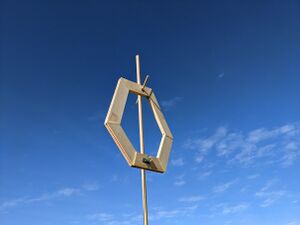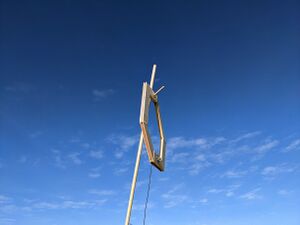Toward a Minor Tech:Mateus
Low Frequency Zones
| Name | Frequency range | Wave length | Signals |
| Super low frequencies | Below 3 Hz | More than 100000 km | Geomagnetic pulsations |
| Ultra low frequencies | 3-30 Hz | 100000-10000 km | Brain electrical activity |
| […] | |||
| Very low frequencies | 3-30 kHz | 100-10 km | Natural radio signals |
| […] | |||
| Low frequencies | 30-300 kHz | 10-1 km | Long wave broadcast |
| […] | |||
| Ultra high frequencies | 2.5 gHz | 12.5 cm | 2.5 gHz Wifi |
| 5 gHz | 6 cm | 5 gHz Wifi | |
| 300 gHz - 430 tHz | 1 mm - 700 nm | Infrared |
Table showing partial range of electromagnetic frequencies [1]
In this essay, I will explore activities at different scales of electromagnetic frequencies and consider how they might be perceived as part of experimental anti-capitalist forms of computation. This is contrasted with the figure of the Hobbyist which overlaps these practices.
The network society[2] is built around an infrastructure of physical nodes that are a familiar part of the environments we live in. The connections between these often remain slightly more hidden, glimpsed as cables disappearing underground, or as things that simply occur outside the bounds of visible light. The transmission of data between these nodes takes place at many points through different zones of the electromagnetic spectrum. It moves stretched and condensed, at wavelengths ranging from approximately 0.00075mm to 125mm.
These moments of transmission are shared excursions – light pulsing through the bandwidth commons of undersea cables, and point to point hopping through CDNs, from street-side cabinets, to domestic routers. Command line tools such as Traceroute can reveal a surface approximation of the network topology through data requests – tracing the hops between networks and the timings between them whilst still obscuring deeper layers of hops.
The paths this data takes follow the paths laid by earlier modes of capitalist extraction, continuing these processes.[3][4] With this in mind, I'd like to turn to the slow data packets, the physically shipped components of what could be called, Hobbyist computation. How does a creative practice that seeks to explore low-power computation resolve the contradictions inherent in its entanglement with global supply chains and systems of infrastructure?
Through their specificity and component breakdown the hobbyist may often reach further into these webs of supply than most consumer practices are required to i.e. through purchasing from platforms such as Alibaba or directly with component manufacturers. Invoking the hobbyist we must also contest with its connotations of a gendered freedom, regular waged work and disposable income. The hobbyist as consumer and nominal endpoint of commodities also carries a precariousness:
"Right now we feel the right thing to do is to prioritise commercial and industrial customers – the people who need Raspberry Pis to run their businesses – we’re acutely aware that people’s livelihoods are at stake." -Raspberry Pi[5]
In the case of the Raspberry Pi (whose mission statement includes “Democratising technology – providing access to tools”[6]) the hobbyist consumers are cut off from the supply, until the demands of the industrial orders are met. The motivations of the hobbyist can not be assumed and hold to no singular political vision. Partly for this reason the hobbyist practices are always at risk of becoming productive to the economies that support them.
For our purposes though, the hobbyist does offer a perspective from which to scope different producers and systems and to access the fringes of the systems and devices that support infrastructure. How do experimental, low-tech practices exist here? How does an experimental, de-colonial practice of computation imagine different methods of engagement with these marketplaces and supply chains?
Another facet of the hobbyist is the accumulation, recycling and restoration of old components. This begins to align with the practices of salvage and repair found in discussions of permacomputing[7] and specific projects such as Collapse OS[8] where a kind of 'scavenger electronics' is proposed.
In thinking about how to occupy these spaces and the tension between salvageable computation and manufactured components I have been building very low frequency radio antennas. These are simple in construction; a coil of wire connected to a headphone jack, and operated through amplification via a PCM recorder. Radio, generally is another field with strong associations to hobby values. [see also higher frequency 'Foxhole Radio' experiments performed by groups such Shortwave Collective[9]]
- ↑ Table data from Radio Nature, Romero, Renato. (2008) and Wikipedia https://en.wikipedia.org/wiki/Infrared
- ↑ Castells, Manuel. The Internet Galaxy, 2001.
- ↑ Starosielski, Nicole. The Undersea Network. Duke University Press, 2015.
- ↑ Foucault, Michel. Archaeology of Knowledge and the Discourse on Language, 1972. ["....Beneath the rapidly changing history of governments, wars, and famines, there emerge other, apparently unmoving histories: the history of sea routes, the history of com or of gold-mining, the history of drought and of irrigation, the history of crop rotation, the history of the balance achieved by the human species between hunger and abundance."]
- ↑ Upton, Eben. ‘Production and Supply-Chain Update’. Raspberry Pi (blog), 4 April 2022. https://www.raspberrypi.com/news/production-and-supply-chain-update/.
- ↑ Raspberry Pi. ‘Raspberry Pi - About Us’. Accessed 19 December 2022. https://www.raspberrypi.com/about/.
- ↑ ‘Principles’. Accessed 19 December 2022. https://permacomputing.net/Principles/.
- ↑ ‘Collapse OS — Bootstrap Post-Collapse Technology’. Accessed 19 December 2022. http://collapseos.org/.
- ↑ Shortwave Collective. ‘Shortwave Collective’. Accessed 19 December 2022. https://www.shortwavecollective.net/.

